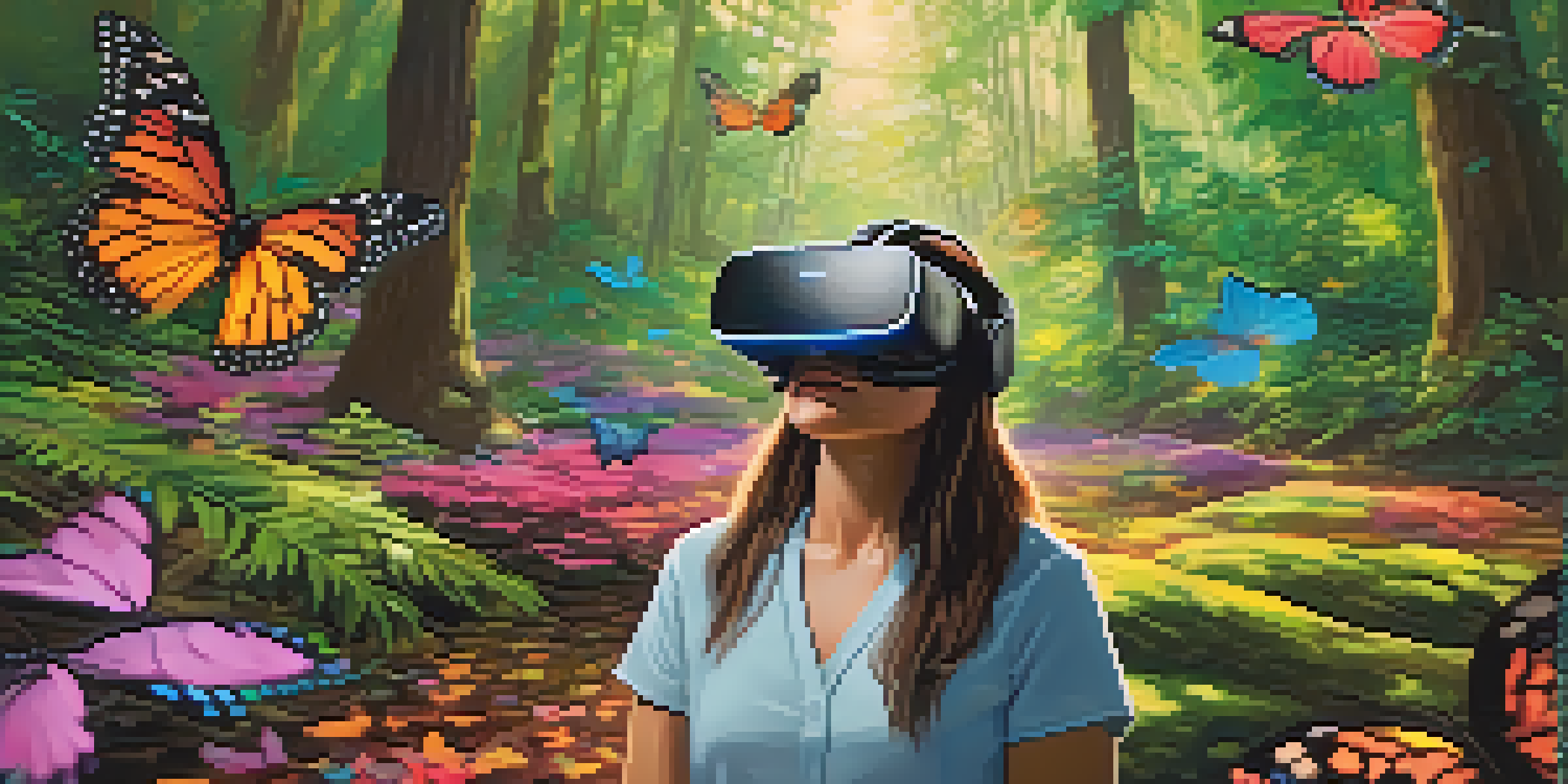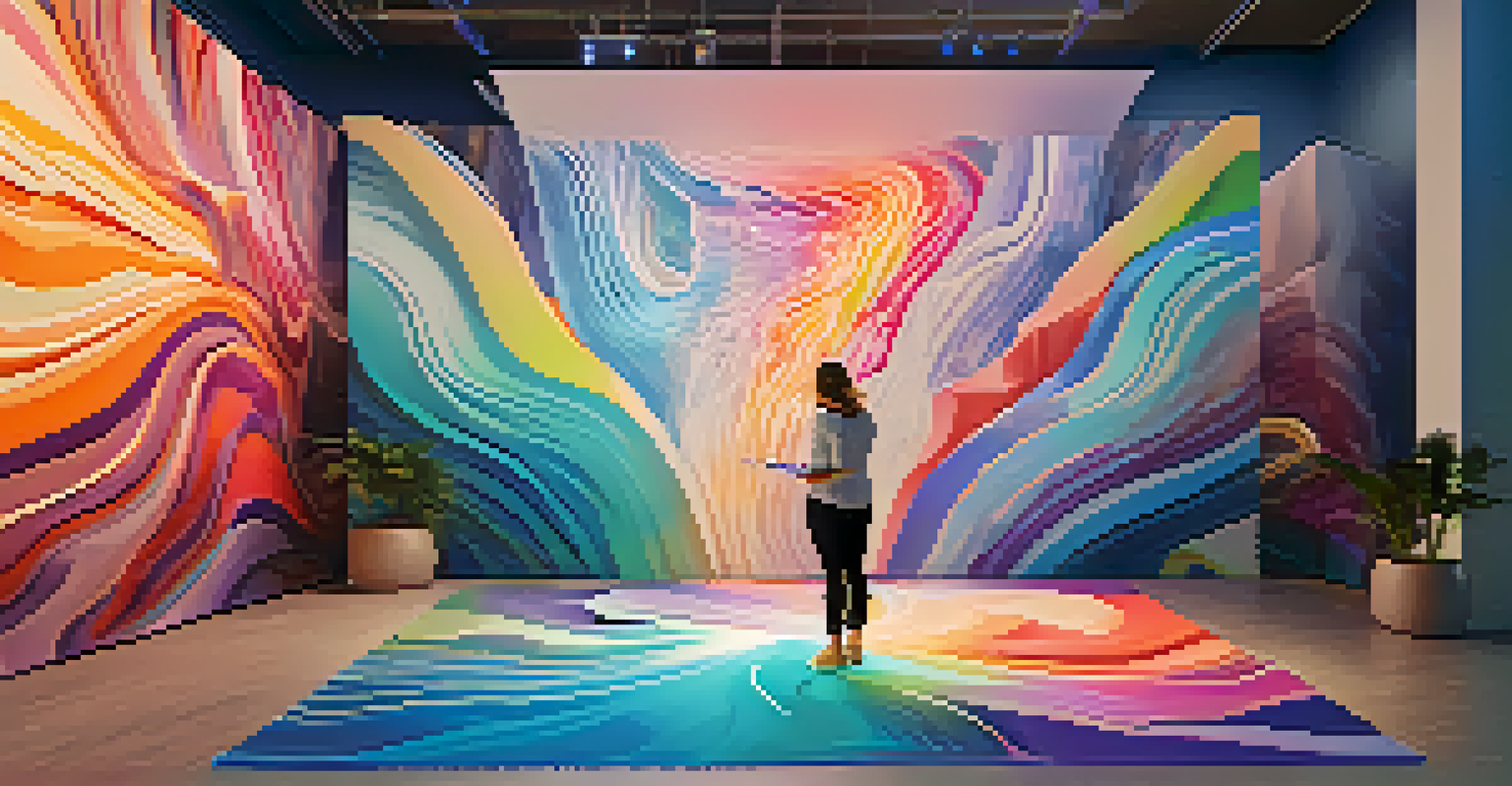Virtual Reality Therapy: Art as a Healing Tool in VR

Understanding Virtual Reality Therapy and Its Impact
Virtual Reality Therapy (VRT) is an innovative approach that utilizes immersive technology to facilitate healing. By creating a simulated environment, VRT allows patients to confront and process their emotions in a safe space. This can be particularly beneficial for those dealing with trauma, anxiety, or depression.
Art is the most beautiful of all lies; it is a form of truth that allows us to express what we cannot say with words.
In essence, VRT combines the elements of traditional therapy with the engaging aspects of virtual reality. Imagine stepping into a serene landscape or a bustling cityscape, all crafted to help you navigate your feelings. This interactive experience can enhance emotional engagement and provide a unique outlet for self-expression.
As the world becomes more digitally connected, the potential for VRT continues to grow. With advancements in technology, therapists and patients alike are discovering new ways to harness the power of VR, making it a vital tool in modern mental health treatment.
Art as a Therapeutic Medium in Virtual Reality
Art therapy has long been recognized for its ability to facilitate emotional expression and healing. In the realm of virtual reality, this concept takes on a new dimension, allowing individuals to create and interact with art in an immersive setting. This transformative experience can make the therapeutic process more engaging and impactful.

Through VR, patients can paint, sculpt, or explore art in ways that may be difficult in the physical world. For instance, a user might create a 3D sculpture that represents their feelings, providing a visual representation of what they are experiencing. This act of creation can be both cathartic and enlightening, helping individuals understand their emotions better.
VRT Enhances Emotional Healing
Virtual Reality Therapy (VRT) provides a safe, immersive environment for patients to confront and process their emotions, making it a valuable tool for those dealing with mental health issues.
Moreover, the digital landscape allows for experimentation without the fear of judgment. Patients can freely explore their creativity, which can lead to breakthroughs in their emotional journey. This unique blend of art and technology enhances the therapeutic experience, making healing a more personalized adventure.
The Science Behind Art and Healing in VR
Research indicates that engaging in creative activities can significantly reduce stress and anxiety levels. By incorporating art into virtual reality therapy, patients benefit from both the therapeutic effects of art and the immersive nature of VR. This combination can lead to profound emotional breakthroughs.
Virtual reality is the first step in a grand adventure into the landscape of the imagination.
Studies have shown that creating art can trigger the brain's reward pathways, releasing feel-good hormones like dopamine. When combined with the immersive experience of VR, patients often experience heightened emotional responses, allowing for deeper processing of their feelings. This scientific backing reinforces the effectiveness of VRT in facilitating healing.
Additionally, VR can help patients confront fear and trauma in a controlled environment, making the process of healing more manageable. By visualizing their experiences through art, individuals can confront their emotions and work through them in a supportive, engaging way. This integration of art and science is paving the way for a new era of mental health treatment.
Case Studies: Success Stories of VRT Using Art
Numerous success stories illustrate the effectiveness of Virtual Reality Therapy with art as a healing tool. For example, a young woman struggling with anxiety found solace in a VR art program that allowed her to express her feelings through painting. Over time, she reported a significant decrease in her anxiety levels and an increased sense of self-worth.
Another case involved a veteran coping with PTSD. Through VR art therapy, he was able to create a digital mural that depicted his experiences during service. This act of creation not only helped him process his trauma but also fostered a sense of community with fellow veterans who shared similar experiences.
Art Therapy in VR Transforms Healing
Combining art therapy with virtual reality allows individuals to express their feelings creatively, leading to deeper emotional understanding and personal breakthroughs.
These stories are just a glimpse into the potential of VRT. As more individuals embrace this innovative approach, the healing power of art combined with virtual reality continues to unfold, offering hope and healing to those in need.
Challenges and Limitations of Virtual Reality Therapy
While Virtual Reality Therapy shows great promise, it is not without its challenges. One of the primary concerns is accessibility; not everyone has access to the necessary technology or resources. This creates a gap in who can benefit from these innovative treatments.
Additionally, some individuals may experience discomfort or motion sickness while using VR. It's crucial for therapists to assess each patient's suitability for VR therapy and provide alternative options when necessary. This ensures that the therapy remains a safe and effective tool for healing.
Lastly, as with any emerging field, ongoing research is essential. Understanding the long-term effects and potential drawbacks of VRT will help refine this therapeutic approach further. With continued exploration, the hope is to make VR therapy accessible and beneficial for a wider audience.
The Role of Therapists in VR Art Therapy
Therapists play a critical role in the success of Virtual Reality Art Therapy. They guide patients through the process, helping to facilitate emotional expression and ensure a safe environment. Their expertise is invaluable in interpreting the art created and understanding its significance within the therapeutic context.
Moreover, therapists can tailor the VR experience to meet the unique needs of each patient. By selecting specific art tools and environments, they can create a personalized journey that resonates with the individual's emotions. This customization is essential in maximizing the therapeutic benefits of VR.
Therapists Guide VR Art Journeys
The role of therapists is crucial in Virtual Reality Art Therapy, as they tailor experiences to individual needs and facilitate emotional expression, enhancing the overall healing process.
Effective communication between therapist and patient is key. As patients explore their creativity in VR, therapists can provide support, encouragement, and feedback, fostering a collaborative atmosphere that enhances the healing process. Together, they navigate the complexities of emotions and creativity, paving the way for meaningful transformations.
The Future of Virtual Reality Therapy and Art
Looking ahead, the future of Virtual Reality Therapy combined with art is bright and full of potential. As technology continues to advance, we can expect even more immersive and interactive experiences that enhance emotional healing. This evolution will likely lead to new therapeutic techniques and applications.
Furthermore, as awareness of mental health issues increases, more practitioners are likely to explore VR as a viable treatment option. This growing interest could result in an expansion of research, leading to a deeper understanding of the benefits and limitations of VRT.

Ultimately, the integration of art and technology in therapy offers exciting possibilities for healing. As we embrace these innovations, we move closer to creating a more compassionate and effective mental health landscape, where art becomes a powerful tool for emotional recovery.